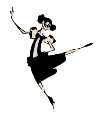 |
ROUND DANCING — CHOREOGRAPHED BALLROOMEDUCATIONAL ARTICLESMAJOR SECTIONS: Figures | Articles | Links | Alph. Index | Search | Home |
|
|
LEARNING TWO STEPby Harold & Meredith Sears It is ironic that the Two Step is the rhythm that many round dancers first learn, it is one of the staples of a square-dance/round-dance evening, and yet the Two Step is a difficult rhythm to learn. There are at least two problems or barriers:
Somehow, making the transition from rhythmic walking to the "step-close-step" pattern is tough. The first step is fine, but the second, closing step is not particularly natural. In "real life" we don't move around by bringing one of our feet only as far as the other and then taking weight on it. So, we try the two-step, but we take a passing step, or we touch when we should close; we hesitate in the wrong place. It feels awkward. On top of that, many supposedly simple, phase I and II figures do not progress in one direction only. They move forward and then abruptly shift to the left or right or back. Consider these:
One learning strategy that can help the dancer get past these problems is to start with side steps. Stepping side, close, side is comfortable, because the second step sort of runs into the first, and you have to close. You can't easily pass. Similarly, instead of forward, close, forward, try forward, lock behind, forward. A locking step or hooking behind the weighted foot forces you to close instead of pass, because you run into the barrier of step one. If you're moving backward, don't try back, close, back, but step back, lock in front, back. It really makes a difference. I tried the "fwd, lk, fwd, -;" on a friend, and she said, "Oh, it's like skipping!" She had no further trouble. You just never know… Another way to think through the "two-step problem" is to focus on the traveling steps, not the closing steps. After all, the rhythm is called "two-step," not "three-step." Don't think, "step, step, step." Instead think, "step, uh, step." Two forward two-steps become, "LEFT, uh, LEFT, RIGHT, uh, RIGHT." Try to deemphasize that closing step. "7-5-3"I recently ran into another technique for easing into the two-step rhythm, called the "7-5-3" method. I read an essay on the topic by Gert-Jan and Susie Rotsheid, who learned it from Bill and Carol Goss, who might have heard of the approach from Mike and Diana Sheridan. It helps us both to close on step two, and to make those seemingly abrupt changes of direction. The key is to get moving and into a rhythm before attempting a change of direction. When you first try to learn a two-step box (see the table above), don't do the "side, close, forward, -; Instead, dance: side, close, side, close, side, close, forward, -; The seven steps give you time to think and to get ready for that forward step. Work on the second half of the box by dancing: side, close, side, close, side, close, back, -; As you become comfortable with these sequences of seven, reduce the pattern to five steps: side, close, side, close, forward, -; side, close, side, close, back, -; And then do it in three, and you have your two-step box. Maybe you can learn the forward hitch simply by thinking of skipping, but if that doesn't work, try forward, lock, forward, lock, forward, lock, back, -; The seven steps give you time to think of having to abruptly change from forward steps to a back step. You have a rhythm going and can swing right into it. Then reduce your preparation or thinking time to five: forward, lock, forward, lock, back, -; Does forward, close, forward, close, back, -; work as well? Then do it in three, and you have your forward hitch. A scissors can be built up to in a "7-5-3" manner by starting with a side, close, side, close, side, close, cross in front (woman in back), -; You have six steps to get ready and then lunge into that crossing step. You can smooth it out later. Finally, the infamous Two Turning Two-Steps can be worked into submission by beginning with a side, close, side, close, side, close, TURN1/2, -; During those side-closes, focus your mind. Here it comes. On the seventh beat, step side and pivot 1/2! You did it. Repeat the seven to turn back to face wall. Gradually reduce to five and then to three. Work on the two-step stepping patterns by putting up barriers to force the closing step on beat two, by emphasizing the traveling steps over the closing steps, and by sneaking up on the direction changes with a "7-5-3" strategy, and the Two-Step will come more easily.
A version of this article was published in the Washington Area Square Dancers Cooperative Association (WASCA) Calls 'n' Cues, 49-10:9, 6-8/2009.
If you would like to read other articles on dance position, technique, styling, and specific dance rhythms, you may visit the article TOC. Past DRDC Educational Articles archived here. Go beyond this site. Find other references on our Sources and Links pages.
|
 |
|
|
Page last revised